2nd Light Horse Regiment, AIF
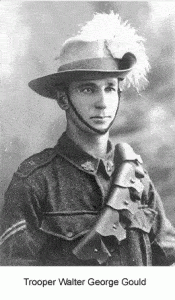
Walter George Gould hailed from Warwick. Aged 24, Walter enlisted on the 26th June 1915 at Brisbane, possibly in response to the casualty lists then
available from Gallipoli. Those who enlisted at this time, were referred to as the “Dinkums” by those who took part in the landings and the continuing campaign. This was because they signed up knowing what they were letting themselves in for, having read the published casualty lists.
Walter Gould was allocated service number 1420 and was appointed to the 11th Reinforcements 2nd Light Horse Regiment. He was promoted to Corporal whilst still training in Queensland and embarked on 4th October 1915. At the end of December he reverted to the ranks and was taken on strength on 9th January.
A week later, Walter was on the move to the front with the 2nd Light Horse (LH) to Wardan on outpost duty. From there the 2nd LH moved through various locations in Upper Egypt until early May, to give confidence to friendly locals and warn off the warlike Senouissi. The 2nd LH encountered no enemy during this period but found it useful in training the reinforcements in mounted work.
The Regiment moved to the Sinai following the Turkish raid on the Suez Canal. Having relieved the 2nd Brigade at Romani, the regiments of 1st Brigade then took turns in the long distance desert patrols. These continued through the months of June and July of 1916.
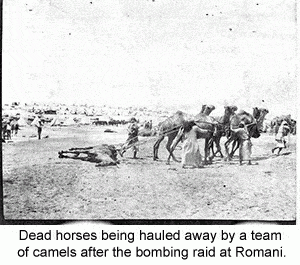 On 1st June, the Brigade received the attentions of an enemy plane which dropped six bombs on the congested camp area. The 3rd Regiment fared worst, losing a number of men and horses. A good many of the Brigade horses stampeded and, according to Lt. Colonel Bourne in the History of the 2nd Light Horse Regiment, A.I.F., they galloped themselves to death in the desert.
On 1st June, the Brigade received the attentions of an enemy plane which dropped six bombs on the congested camp area. The 3rd Regiment fared worst, losing a number of men and horses. A good many of the Brigade horses stampeded and, according to Lt. Colonel Bourne in the History of the 2nd Light Horse Regiment, A.I.F., they galloped themselves to death in the desert.
Walter Gould was there and, like many others, he had a camera. Walter sent home an interesting collection of photos taken during the campaign. These photos have been made available by Walter’s son, Ken.
The photograph, though faded, shows a number of dead horses in the foreground with troopers surveying the scene. The inscription on the back of the photo reads, “ Romani 1st of June ’16 after a bomb run.”
The battle for Romani was fought on 4th August with the ANZAC Mounted Division bearing the brunt of the fight. This proved to be a strategically important battle because the Turks never recovered the initiative after their defeat at Romani.
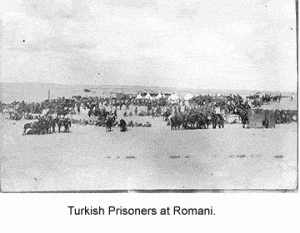
As the Turks withdrew, the Light Horse Regiments pursued them to Katia where another brisk engagement ensued. By the afternoon of 5th August, the men
of 2nd LH were exhausted, after two nights without sleep and their horses had not had water for 52 hours. The Turks were well entrenched and it was decided to withdraw to Romani to rest.
After further attempts to strike at the Turkish rearguard, a period of reduced activity followed as the earlier, arduous patrolling had impaired the health of the men. At the end of September, the 2nd LH moved to Kantara for a six week spell. It was during this period that Walter Gould was transferred to the 1st Light Horse Brigade H.Q. to be a driver.
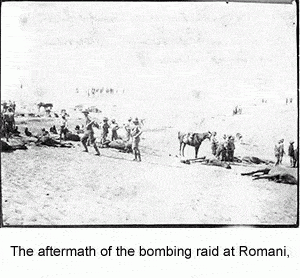 After their spell, the 2nd LH continued the advance, along with other units of the Desert Column. There are a number of mentions in unit histories of the Light Horsemen gathering firewood from any available source so they could brew up when the opportunity presented itself. Walter Gould has captured an excellent example of Light Horsemen making the best of what was available to them at El Arish.
After their spell, the 2nd LH continued the advance, along with other units of the Desert Column. There are a number of mentions in unit histories of the Light Horsemen gathering firewood from any available source so they could brew up when the opportunity presented itself. Walter Gould has captured an excellent example of Light Horsemen making the best of what was available to them at El Arish.
From El Arish, the ANZAC Mounted together with the Camel Brigade and attached artillery marched up the Wadi El Arish to attack the Turkish positions at Magdhaba. The attack opened shortly after dawn on 23rd December 1916. Initially, the progress was good but slowed due the heavy fire brought to bear by the Turkish defenders who were well concealed. Despite good shooting on the part of the artillery, their guns were too few and too light.
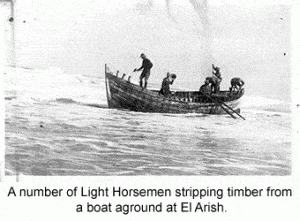
A reconnaissance report from the 1st Squadron of the Australian Flying Corps revealed that there was no threat of reinforcement. The real threat to the operation was that water could not be obtained nearby. With the Turks still in possession of the wells of Magdhaba, the nearest water available was 23 miles away at El Arish.
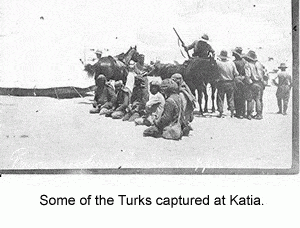
When General Chauvel was advised that engineers had not been able to locate water in the vicinity of Bir Lafhan, he decided that he should break off the action, after considering the reports from the Brigades in the early afternoon. After advising General Chetwode of his intentions, Chauvel sent out an order to the Brigades that they should withdraw.
Brigadier Cox, who was leading the 1st Brigade (ALH), chose to fight on. On receiving the order, he said, “Take that damned thing away and let me see it for the first time in half an hour.” Shortly after the 2nd Redoubt fell to the 3rd LH Regiment, the tide swung in favour of the attacking force. Shortly after, the 10th LH Regiment had manoeuvred right around the Turks and were attacking from the South. The encircled garrison surrendered at 4.30pm.
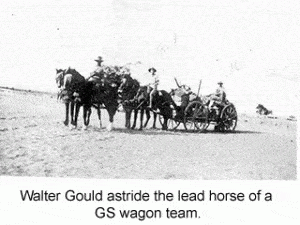
The pressure was kept up on the Turkish forces. On 9th January 1917, the 2nd LH Regiment was in action again at Rafa with other elements of the Desert Column. The main fighting was against the entrenched positions at El Magruntein and Hill 255. Although the operation was similar to the one carried out at Magdhaba, it was a much stronger position. Again, water was a problem and this time the position was only captured just in time before Turkish reinforcements arrived.
With all reserves committed, it was the sighting of the approach of strong reinforcements that concerned Chetwode.
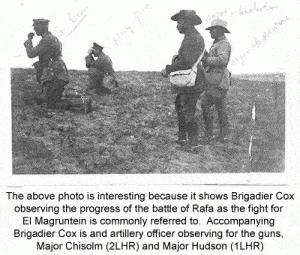
After speaking with Chauvel, he decided to withdraw at 4.25pm. But before the orders could be drawn up, Chauvel observed troops coming over the top of the Reduit. This time it was the New Zealanders and the Camels that carried the day.
After these initial battles, Walter served throughout the campaign with the 1st LH Brigade HQ, transporting supplies, until he was taken to hospital on 9th November 1918 where he was diagnosed as having malaria as were many others.
Two days later he was moved to the Australian General Hospital at Port Said. On 26th January 1919, Walter Gould embarked on the ‘Demosthenes’ and returned to Australia.
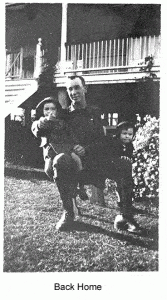 Walter returned to his pre-war occupation of teaching and eventually became the head teacher of the Bald Hills State School.
Walter returned to his pre-war occupation of teaching and eventually became the head teacher of the Bald Hills State School.
When it appeared likely that the Japanese would invade Australia, Walter Gould, like many other ex servicemen, joined up in the Volunteer Defence Corps to again serve his country.
Many thanks go to Ken Gould for kindly sharing these photos from his father’s collection.
Trooper Wattle – with further historical data from Deborah Chalker
| Regimental number | 1420 |
| Religion | Church of England |
| Occupation | School teacher |
| Address | Mondure North, Wondai, Queensland |
| Marital status | Married |
| Age at embarkation | 34 |
| Next of kin | Wife, Mrs Elsie Frances Harriett Gould, Mondure North, Wondai, Queensland |
| Enlistment date | 26 June 1915 |
| Rank on enlistment | Private |
| Unit name | 2nd Light Horse Regiment, 11th Reinforcement |
| AWM Embarkation Roll number | 10/7/3 |
| Embarkation details | Unit embarked from Sydney, New South Wales, on board HMAT A47 Mashobra on 4 October 1915 |
| Rank from Nominal Roll | Private |
| Unit from Nominal Roll | 2nd Light Horse Regiment |
| Returned to Australia 28 January 1919 |
